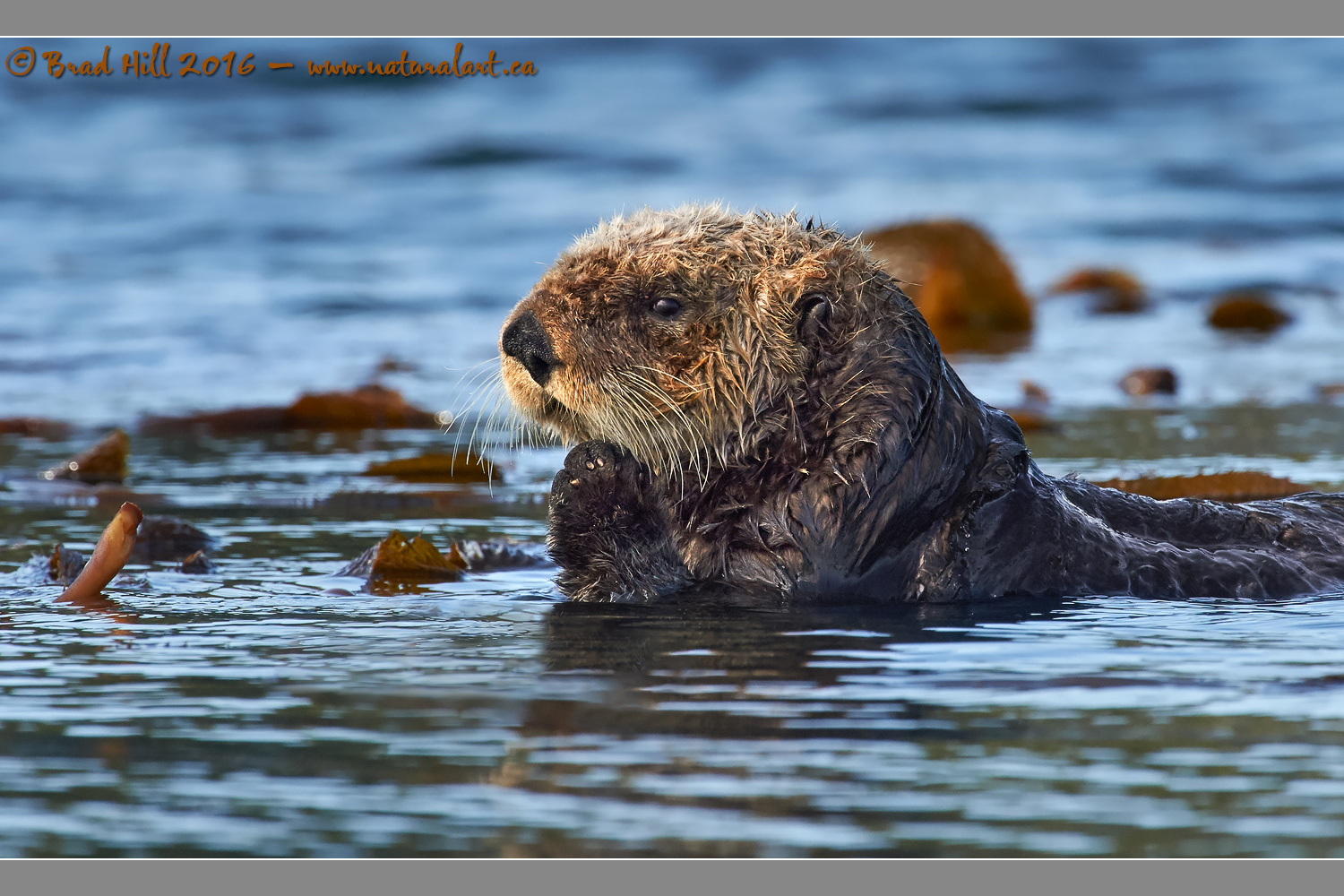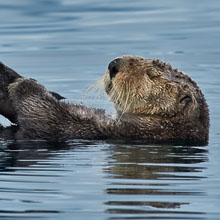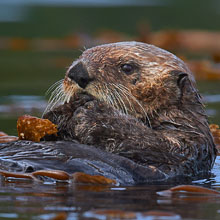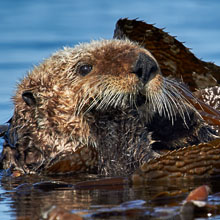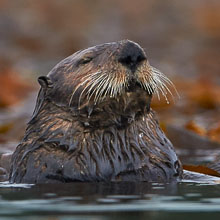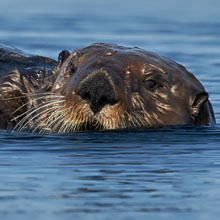Availability: Undetermined - Enquiries?
In the Field
Pawsing to Ponder. Northern Vancouver Island region, BC, Canada. August 13, 2015.
All of us have places where we're most comfortable. For bighorn sheep and mountain goats it tends to be on steep rock faces where they can easily escape predators. For black bears it's usually within a forest (and not out in open terrain). Where are sea otters most comfortable? DEFINITELY within thick kelp forests that are being rocked by ocean swells. If you're ever going to find these almost hyperactive animals sleeping or resting, odds are it will be in a thick bed of kelp!
This male sea otter was kicking back a bit when I captured this image. Most of the time sea otters lounge on their back and they spend relatively little time laying stomach down. One interesting aspect of sea otter behavior is that they will wrap themselves up in kelp leaves - to anchor themselves in place - before they grab 40 winks. This guy was in the very process of wrapping himself in kelp leaves (via spinning in the water) when he stopped for a few minutes in this "stomach side down" orientation and looked content and contemplative. When he raised his little front paw up it looked just like he was pondering something and I couldn't resist grabbing this shot!
I captured this shot with a Nikkor 400mm f2.8E VR lens paired up with the TC-20EIII (2x) teleconverter, giving me a total focal length of 800mm. While I have historically avoided using teleconverters, Nikon's latest versions (the series III teleconverters) CAN produce great quality images on selected lenses (and if they're used with care). I still never use them with zoom lenses. In fact, I use them only with some of Nikon's best prime lenses, and find that the f2.8 maximum aperture on the superb Nikkor 400mm f2.8 makes using teleconverters quite practical in a field setting (and much more so than f4 lenses, especially when using the 2x TC). And, I still stop down at least 1/3 (and more often 2/3) of a stop from wide open whenever I'm using a TC (to ensure maximum sharpness). This means that when I'm using the TC-20EIII on the 400mm f2.8E VR (which reduces its maximum aperture to f5.6) I rarely shoot it at larger apertures than f7.1. In this image I stopped down to f11, though that was partly motivated to achieve a sufficient DoF for this image.
Here's higher-resolution (2400-pixel) version of this shot for all those otter lovers out there!
• Pawsing to Ponder: Download 2400 pixel image (JPEG: 1.5 MB)
ADDITIONAL NOTES:
1. This image - in all resolutions - is protected by copyright. I'm fine with personal uses of it (including use as desktop backgrounds or screensavers on your own computer), but unauthorized commercial use of the image is prohibited by law. Thanks in advance for respecting my copyright!
2. Like all wildlife photographs on this website, this image was captured following the strict ethical guidelines described in The Wildlife FIRST! Principles of Photographer Conduct. I encourage all wildlife photographers to always put the welfare of their subjects above the value of their photographs.
3. This image was captured during my "Humpback, Orcas, Sea Lions & More" photo tour in August of 2015. Each year I offer trips into two different parts of the Great Bear Rainforest as well as one to photograph aquatic mammals and oceanscapes near the northern tip of Vancouver Island. And, in selected years, I also offer photo tours to locations to capture other highly sought-after subjects, such as various owl species of the boreal forest and wildlife of Canada's Arctic. Details about these trips can be found on the Photo Tours page of this website.
Behind the Camera
Pawsing to Ponder. Northern Vancouver Island region, BC, Canada. August 13, 2015.
Digital Capture; Compressed RAW (NEF) 14-bit format; ISO 1800.
Nikon D4s paired with Nikkor 400mm f2.8E VR plus TC-20EIII (2.0x) teleconverter, for a total focal length of 800mm. Hand-held from floating Zodiac. VR on and in "Sport" mode.
1/1250s @ f11; no compensation from "recommended" matrix-metered exposure setting.
At the Computer
Pawsing to Ponder. Northern Vancouver Island region, BC, Canada. August 13, 2015.
RAW Conversion to 16-bit TIFF using Phase One's Capture One Pro 9. Five raw variants (different versions of a single raw capture) processed, with the variants differing in exposure (1.3 stop total difference between the variants) and both highlight and shadow retrieval settings.
Further digital corrections on resulting 16-bit TIFF files using Adobe's Photoshop CC 2015. Photoshop adjustments included compositing (blending) of the five output files from the raw converter, minor exposure and selective contrast tweaks, and final selective sharpening for web output.
Conservation
Pawsing to Ponder. Northern Vancouver Island region, BC, Canada. August 13, 2015.
Ten percent of the revenue generated by this image will be donated to Raincoast*.
Species Status in Canada**: Special Concern (April 2007) - protected off the North American coast since 1911.
Back in the late 1800's and early 1900's the Sea Otter (Enhydra lutris) was hunted to near extinction along both the Asian and North American Pacific Coasts. The reason? It's luxuriant coat. Otters are unlike any other aquatic mammal in that they don't use fat or blubber to insulate themselves from the chilling effects of the water they are found in. Instead, they rely on their amazingly thick fur coat for insulation. Their amazing coats have a higher density of hair (up to 150,000 strands of hair per square cm!) than any other animal in existence today. To ensure that this coat serves its insulative purpose, otters spend a disproportionately large amount of time grooming their coat (to ensure its natural oils continue to provide an effective waterproof barrier). Unfortunately, the biological functioning of the otters coat can be easily fouled by contamination by oil and other hydrocarbons - thus making them extremely sensitive to the effective of marine oil spills.
Other fascinating aspects of the biology and behaviour of the sea otter include the use of tools (they will use rocks to break apart shellfish such as sea urchins), and the fact that they have an metabolic rate two to three times higher than other mammals of their size. This means they must eat 23% to 33% of their own body weight DAILY, just to to replace the calories burned through maintaining their body temperature in the cold water environment they live in.
*The Raincoast Conservation Society (and Foundation) is an effective and efficient organization that has been fighting for protection of this unique habitat. If you are looking for a meaningful way to contribute to the conservation of this amazing ecosystem, Raincoast will provide maximal "bang" for your conservation dollars.
**as determined by COSEWIC: The Committee on the Status of Endangered Wildlife in Canada












